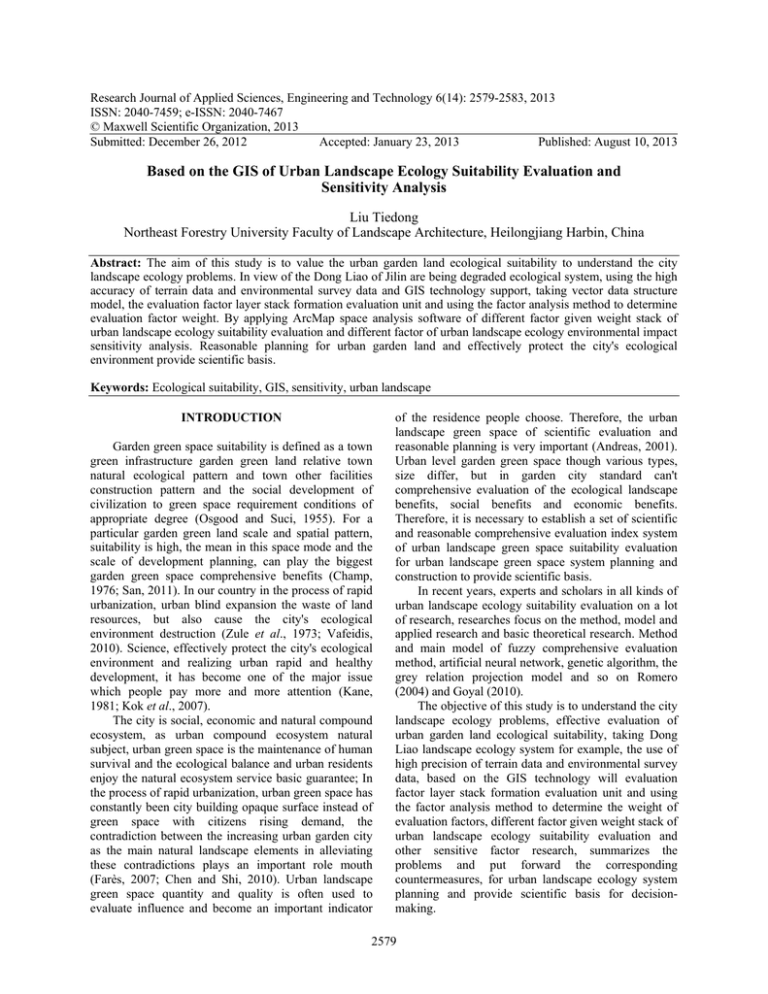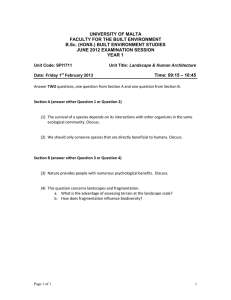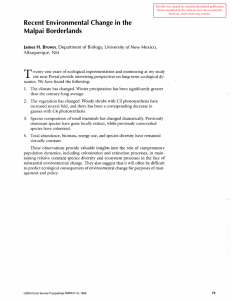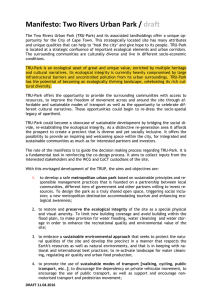Research Journal of Applied Sciences, Engineering and Technology 6(14): 2579-2583,... ISSN: 2040-7459; e-ISSN: 2040-7467
advertisement

Research Journal of Applied Sciences, Engineering and Technology 6(14): 2579-2583, 2013
ISSN: 2040-7459; e-ISSN: 2040-7467
© Maxwell Scientific Organization, 2013
Submitted: December 26, 2012
Accepted: January 23, 2013
Published: August 10, 2013
Based on the GIS of Urban Landscape Ecology Suitability Evaluation and
Sensitivity Analysis
Liu Tiedong
Northeast Forestry University Faculty of Landscape Architecture, Heilongjiang Harbin, China
Abstract: The aim of this study is to value the urban garden land ecological suitability to understand the city
landscape ecology problems. In view of the Dong Liao of Jilin are being degraded ecological system, using the high
accuracy of terrain data and environmental survey data and GIS technology support, taking vector data structure
model, the evaluation factor layer stack formation evaluation unit and using the factor analysis method to determine
evaluation factor weight. By applying ArcMap space analysis software of different factor given weight stack of
urban landscape ecology suitability evaluation and different factor of urban landscape ecology environmental impact
sensitivity analysis. Reasonable planning for urban garden land and effectively protect the city's ecological
environment provide scientific basis.
Keywords: Ecological suitability, GIS, sensitivity, urban landscape
INTRODUCTION
Garden green space suitability is defined as a town
green infrastructure garden green land relative town
natural ecological pattern and town other facilities
construction pattern and the social development of
civilization to green space requirement conditions of
appropriate degree (Osgood and Suci, 1955). For a
particular garden green land scale and spatial pattern,
suitability is high, the mean in this space mode and the
scale of development planning, can play the biggest
garden green space comprehensive benefits (Champ,
1976; San, 2011). In our country in the process of rapid
urbanization, urban blind expansion the waste of land
resources, but also cause the city's ecological
environment destruction (Zule et al., 1973; Vafeidis,
2010). Science, effectively protect the city's ecological
environment and realizing urban rapid and healthy
development, it has become one of the major issue
which people pay more and more attention (Kane,
1981; Kok et al., 2007).
The city is social, economic and natural compound
ecosystem, as urban compound ecosystem natural
subject, urban green space is the maintenance of human
survival and the ecological balance and urban residents
enjoy the natural ecosystem service basic guarantee; In
the process of rapid urbanization, urban green space has
constantly been city building opaque surface instead of
green space with citizens rising demand, the
contradiction between the increasing urban garden city
as the main natural landscape elements in alleviating
these contradictions plays an important role mouth
(Farès, 2007; Chen and Shi, 2010). Urban landscape
green space quantity and quality is often used to
evaluate influence and become an important indicator
of the residence people choose. Therefore, the urban
landscape green space of scientific evaluation and
reasonable planning is very important (Andreas, 2001).
Urban level garden green space though various types,
size differ, but in garden city standard can't
comprehensive evaluation of the ecological landscape
benefits, social benefits and economic benefits.
Therefore, it is necessary to establish a set of scientific
and reasonable comprehensive evaluation index system
of urban landscape green space suitability evaluation
for urban landscape green space system planning and
construction to provide scientific basis.
In recent years, experts and scholars in all kinds of
urban landscape ecology suitability evaluation on a lot
of research, researches focus on the method, model and
applied research and basic theoretical research. Method
and main model of fuzzy comprehensive evaluation
method, artificial neural network, genetic algorithm, the
grey relation projection model and so on Romero
(2004) and Goyal (2010).
The objective of this study is to understand the city
landscape ecology problems, effective evaluation of
urban garden land ecological suitability, taking Dong
Liao landscape ecology system for example, the use of
high precision of terrain data and environmental survey
data, based on the GIS technology will evaluation
factor layer stack formation evaluation unit and using
the factor analysis method to determine the weight of
evaluation factors, different factor given weight stack of
urban landscape ecology suitability evaluation and
other sensitive factor research, summarizes the
problems and put forward the corresponding
countermeasures, for urban landscape ecology system
planning and provide scientific basis for decisionmaking.
2579
Res. J. Appl. Sci. Eng. Technol., 6(14): 2579-2583, 2013
ECOLOGICAL SUITABILITY AND
SENSITIVITY EVALUATION
BASED ON GIS
garden green space as the basic goal, the suitability of
the basic principles mainly consider the following:
Select urban landscape ecology evaluation factors:
Topography and surface coverage type is affected the
city landscape ecology system of the two basic factors.
They not only control the soil development,
hydrological condition of differentiation, but also
influence the occurrence of soil and water loss, decided
to land use space differentiation. Vegetation cover type
is land ecological system the external performance, its
abundant biological production function is the system
has the size of the mark. Vegetation and land ecological
system in the process of all has a direct or indirect
relationship, the typical environmental protection and
control function. In order to protect the mountain
natural vegetation, maintenance and optimization of its
original habitat factors from alien species and the
influence of human activity, from the influence of the
factors of natural vegetation landscape, through the
suitability evaluation to identify the study area
development and protection of natural forest area, as
the key to study the foundation of ecological
optimization pattern.
Comprehensive consideration of the Dong Liao
city development goals and urban land use current
situation and the current problems in urban
construction, the selection of the water, land use status,
slope, geology, geomorphology, reserve factors as
evaluation factors, waters include rivers, lakes and
reservoirs and other surface waters in improving urban
landscape quality, improve the city space environment,
adjust the urban temperature humidity, maintain normal
water cycle, etc. and at the same time, plays an
important role in the waters near the ecological
environment has great influence on the development of
urban land, in principle, should as far as possible away
from the water to water so as to avoid the destruction of
ecosystem and water pollution. The existing land use
mode determines urban landscape ecological suitability.
Terrain is influence on the land development and
construction of one of the limiting factors, too steep
slope is easy to cause the various geological disasters,
generally not suitable for urban landscape green space
planning. Nature reserves, scenic spots, forest park
Dong Liao natural condition is superior has rich
biodiversity system many types of plants and animals,
nature reserves, scenic spot and the forest park should
be protected prohibited development and construction.
Determining the evaluation unit: Based on the
evaluation factors, in order to protect and develop large
Table 1: The classification of residential elements
Score
91-100
Evaluation classification
Actor
Density
0.26-0.3
Residential
>0.2
Level
>10.0
•
•
•
•
•
The development of high priority (i.e., high
suitability or lower resistance value)
with the increase of the slope, the priority of
development has increased
Evergreen broad-leaved forest and simao pine
forest as the main protection object, so the existing
forest land should be as development evergreen
broad-leaved forest and pine wood preferred
location
The vegetation types and key protection types of
vegetation characteristics more close, the species
motion resistance is small
Gentle slope cultivated land, especially the low
altitude area, the gentle slope of the cultivated land
should be protected as the basic farmland, 6
influence by human land types, its development
has great value of resistance. First based on the
evaluation factors and grading standards, based on
the research of Digital Elevation Model (DEM),
which generate landscape level hierarchical graph
and grade classification diagram; Based on the
above evaluation of the basic principle of in front
of the evaluation factor layer, grade assessment
score.
Establish spatial attribute database: This study, in
accordance with the urban landscape of land ecological
suitability degree it is divided into five levels: the most
appropriate, is suitable, basic suitable, not suitable for
and not land. Will not suitable for land and not land
belong to basic ecological control area, in this area to
ban all construction activities, to ensure that the
ecological security; Will the most suitable land and is
suitable to land into construction control area, land for
construction purposes generally can't surpass this area;
The basic appropriate land belong to ecological buffer
area, used in the basic ecological control area and
construction control area isolation, to ensure that they
are a buffer space. Each objective is corresponding to a
group of factors, geographic information coding model
is to attribute the repository geographic information and
knowledge base of geographic information undertake
unity coding model, of which each factor can be
compiled for a code. For each evaluation factor are
divided into different types of indicators. Such as
Table 1.
71-90
Good
0.21-0.2
0.15-0.2
10.00-6.0
51-70
Can be
0.16-0.20
0.10-0.15
6.00-5.00
2580
31-50
Difference
0.11-0.15
0.05-0.10
5.00-4.04
0-30
Inferior
<0.10
<0.05
<4.00
Res. J. Appl. Sci. Eng. Technol., 6(14): 2579-2583, 2013
APPLICATION
Data sources: Data from the description of natural,
social status words, maps and other data; 1: 10000
topographic map, as shown in Fig. 1; Vegetation
pattern. Terrain data: 1:1000 based on the data of
topographic map, the RTK surveying and mapping
field, draw 1 to electronic topographic map and
converted into GIS available data format. Using
artificial interaction and supervised classification
methods which patch information and the plaque
attribute assignment, the establishment of terrain
prototype model and image between direct and indirect
relations.
Factor analysis method to determine the weight: If
there are n index, each sample has p variable, (x 1 ,
x 2 , L, x p ), thus constitutes an order n × p matrix:
x11 x12 K
x
x22 K
21
X =
M M
xn1 xn 2 K
x1 p
x2 p
M
xnp
Fig. 1: Original data
min { xij } +ρ max {∆ ij }
ξij = 1≤i ≤ n
1≤ i ≤ n
The sample X i and the optimal sample correlation
degree r i :
ri =
U = {u1 ,u2 ,u3 , L ,un }
Then determine the evaluation set: V = {v 1 , v 2 , x 3 , L,
v n }. As the membership function with specific
problems, combined with the actual situation, for the
qualitative, quantitative factors take scoring system
(Thierry de et al., 2007):
x
1- 2a
1
v1 (x)=
a
+
a
1
2 -2 x
2(
a
2 -a1 )
=
X LF + ε
Type of:
F = ( F1 , F2 L , Fm )
∆12 K
∆ 22 K
M
∆n2 K
∆1 p
∆ 2 p
M
∆ np
0
2 x-(a1 +a2 )
v3 (x)=
2(a2 -a1 )
a2
1 2x
X oj = max { xij } ,j =1,2,3, L ,p
1≤ i ≤ n
On the absolute difference matrix transform data as
follows:
x ≤ a1
a <x ≤
a1 +a2
2
x
x ≤ a1
2a
1
a +a
a1 +a2 -2 x
a <x ≤ 1 2
1
2
2(a2 -a1 )
v2 (x)=
x
a
a
a
a
2
-(
+
)
+
11
2
1
2
<x ≤ a2
2(a2 -a1 )
2
a2
x >a2
2x
l1 p
l2 p
M
lnp
Optimal sample: X 0 = (x 01 , x 02 , L, x 0p ) T can be
by the formula structure:
∆11
∆
21
L=
M
∆ n1
1 p
∑ ξij ,i=1,2,3,L ,n
p j =1
First of all, to determine the evaluation factor set:
In general, the original data with different
dimensions or volume level, in order to ensure the
reliability of the analysis results, the need for variable
dimensionless normalization. The standardization and
dimension reduction, p variables can be integrated into
a m new index, the variable can be expressed by the
linear: F 1 , F 2 L, F m , the variable X can be expressed by
the F m linear:
l11 l12 K
l
l22 K
21
L=
M M
ln1 ln 2 K
1≤ i ≤ n
∆ ij +ρ max {∆ ij }
a1 +a2
2
a1 +a2
<x ≤ a2
2
x≤
x >a2
Spatial overlay analysis: Realize tool for ArcGIS 9.2
weighted superposition spatial analysis model. First the
2581
Res. J. Appl. Sci. Eng. Technol., 6(14): 2579-2583, 2013
0
120
100
100
200
80
300
400
60
500
40
600
20
700
Fig. 2: Current land use map
800
0
Fig. 4: Urban landscape ecological suitability assessment
Table 2: The listing after 3 years
0
Mean value
18.520
The median
16.680
Standard
9.975
Observation value
209
Significant level
Fig. 3: Urban landscape green space distribution
grid data format of each evaluation factor analysis
according to the grading standard results are heavy
classification and then combined with the weight of
each factor and calculates the value of ecological
sensitivity comprehensive score. According to the
superposition of the diagram to score, the factor of
ecological sensitivity analysis is the use of GIS
technology in the grid data attribute list add area
attribute fields, calculate the sensitivity level area, then
get the factor of ecological sensitivity data. Space stack
effect such as Fig. 2 and 3.
SUITABILITY EVALUATION AND
SENSITIVITY ANALYSIS
The city landscape ecology factor suitability
evaluation: According to the urban landscape green
space ecological suitability rating system (Table 1) the
heavy classification, will not be suitable for land, not
land belong to basic ecological control area, will be the
most suitable land, the land is suitable to be divided
into construction control area, the basic appropriate
land as ecological buffer area. Using ArcGIS output
classification results (Fig. 4), from Fig. 4 can see the
model, the method to determine the basic ecological
control area and the basic ecological line are consistent
with each other, so the GIS model is practical and
scientific. In the process of performance evaluation, in
order to reflect the principle of ecological protection
priority, the first use of ArcGIS software on ecological
safety factors of basic farmland protection, nature
reserves, protect water and humanistic landscape four
indexes Mosaic operation get protected areas; Will
these four for the offspring are weighted superposition
operation. Evaluation scores Table 2.
1
17.410
15.810
8.439
209
***
2
12.620
11.690
5.370
209
***
3
10.670
8.720
6.457
209
***
The city landscape ecology sensitivity factor
comprehensive evaluation analysis: The so-called
ecological sensitivity is to point to in no loss or don't
reduce the environmental quality between feeling
distribution, for the prevention and control of the
ecological environment and related regional policy
formulation provides scientific basis. According to the
research of ecological environment features, combined
with the research focus and objective conditions,
comprehensive analysis of many factors, choose
elevation, gradient, slope direction, vegetation
coverage, river water, land cover types six factors as
Dong Liao urban landscape ecological sensitivity
analysis of evaluation factors. To ecological factors on
ecological environmental impact way and the degree of
its classification, will be a single ecological factor
sensitive degree is divided into 5 levels, in turn, is very
sensitive area, highly sensitive area, moderate sensitive
area, light sensitive area and not sensitive area Table 3.
Don't sensitive is mainly refers to the ecological
environment basic stability, in the natural conditions
and biological activities of the interference not prone to
ecological environment problems. Don't sensitive area
accounts for 4.14% of the total area, mainly distributed
in the central valley and a flat area, frequent human
activities. Light sensitive is mainly refers to the
ecological environment basically stable, but in the
natural conditions and biological activities of the
interference will appear under mild ecological
environmental problems. Light sensitive area accounts
for 2.87% of the total area, the area is the smallest,
mainly distributed in the relief is not big and vegetation
coverage, human activities more frequent area.
Moderate sensitivity refers to the ecological
environment is stable, but in the natural and human
2582
Res. J. Appl. Sci. Eng. Technol., 6(14): 2579-2583, 2013
Table 3: Single element sensitivity classification evaluation result
Evaluation factors
Not sensitive
Light sensitive
Elevation
11.28
13.46
Slope
9.75
14.05
Vegetation coverage
34.65
36.01
River waters
30.21
44.14
Land cover types
14.78
50.12
action may destroy the original ecological environment,
resulting in large degree of ecological environment
problems. Moderate sensitive area accounts for 36% of
the total area, in addition to the southern mountain area.
No distribution widely distributed in the central valley.
And the eastern mountain slope in the relatively
concentrated distribution. These areas are relatively low
altitude, slope vegetation is rich, larger. Highly
sensitive, extremely sensitive is refers to the fragile
ecological environment, in the natural and man-made
easy appear under the action of ecological environment
problems or has appeared the ecological environment
problem.
CONCLUSION
Moderately sensitive
16.54
20.83
49.32
39.01
20.81
Highly sensitive
20.01
23.53
41.53
23.81
29.05
Extremely sensitive
40.89
60.21
55.43
47.26
64.11
ACKNOWLEDGMENT
The work was supported by “the Fundamental
Research Funds for the Central Universities” Project
number: DL12BA15.
REFERENCES
Andreas, M., 2001. Three-dimensional modeling and
visualization of vegetation for landscape
simulation. Landscape Urban Plann., 54: 5-17.
Champ, P., 1976. Evaluating english landscapes-some
recent developments. Env. Plann., 18: 79-82.
Chen, H.F. and Z. Shi, 2010. Comprehensive evaluation
of tobacco ecological suitability of Henan Province
based on GIS. Agr.Sci.China, 10(16): 29-33.
Farès, B., 2007. Terrain modeling: A constrained fractal
model. Proceeding of the 5th International
Conference on Computer Graphics, Virtual Reality,
Visualisation and Interaction in Africa, New York,
pp: 197-204.
Goyal, S.K., 2010. GIS based spatial distribution
mapping and suitability evaluation of groundwater
quality for domestic and agricultural purpose in
Kaithal district. India Env. Earth Sci., 12(9): 28-34.
Kane, P.S., 1981. Assecssing landscape attractiveness:
A comparativelest of two new methods. Appl.
Geograph., 1: 79-86.
Kok, L., S. Kreijkamp-Kaspers, D.E. Grobbee, E.H. de
Haan, A. Aleman and Y.T. van der Schouw, 2007.
Dietary phytoestrogen intake and cognitive
function in older women. J. Gerontol. A Biol. Sci.
Med. Sci., 62(5): 556-562.
Osgood, C.E. and G.J. Suci, 1955. Factor analysis of
meaning. J. Exp. Psychol., 50(5): 325-338.
Romero, B.L., 2004. Spatial access to health care in
Costa Rica and its equity: A GIS-based study. Soc.
Sci. Med., 58: 1271-1284.
San, D., 2011. Methodology for quantifying
groundwater abstractions for agriculture via remote
sensing and GIS. Water Resour. Manag., 22(13):
45-52.
Thierry de, K., K. Marcvan and L. Maarten, 2007.
Generating realistic terrains with higher-order
Delaunay triangulations. Comp. Geomet., 36(1):
52-65.
Vafeidis, A.T., 2010. A proposed method for modelling
the hydrologic response of catchments to burning
with the use of remote sensing and GIS. Catena,
8(10): 34-40.
Zule, E.H., T. Anderson and D. Pitt, 1973. Measuring
the landscape perceptual responses and physical
dimension. Landscapes Res. News, 1(6): 1-5.
Compared with the traditional numerical evaluation
method, based on the GIS of urban landscape ecology
suitability evaluation method will ground information
acquisition, numerical calculation and spatial data
processing organic combination, can be simple,
intuitive, convenient and fast to quantitative analysis.
This research in ecological investigation, on the basis of
comprehensive consideration of the influence of urban
construction land of natural, social and ecological
factors, follow the "ecological priority," the principle of
selecting evaluation index. Using factor analysis
method to determine the weight of every evaluation
index, reduced the weight evaluation of subjectivity.
Using multi-factor comprehensive evaluation model of
urban landscape ecology suitability evaluation, on the
basis of the actual situation into basic ecological control
area and construction control area, from the protection
of urban ecological security point of view, urban land
use Suggestions to urban landscape ecology
environment of scientific evaluation and urban
development in the future is of great significance.
By the use of GIS technology in the research of
ecological environment problems, the selection of
evaluation factors, on the ecological sensitivity, a
comprehensive appraisal is made on the results of the
study can be used as ecological planning design,
ecological environment protection and urban ecological
construction reference. The results of the evaluation of
ecological sensitivity, on the one hand, largely depends
on the level of evaluation data, on the other hand
depends on the evaluation method. Therefore, in the
future research work to carry out all-round, accurate,
targeted urban landscape ecology environment survey
and establish a rational urban landscape ecological
suitability evaluation method system, in order to better
serve the current ecological environment problems
faced by the service.
2583






